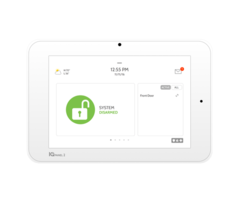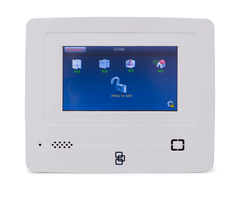How Does Home Security Work?
Home security works by having an alarm system send outbound communication signals to a central monitoring station and/or to an end user. Various security sensors are programmed with the alarm system, and the control panel sends outbound alerts when a security sensor is activated.
The central hub of any alarm system is the control panel. This represents the brains of the entire setup. Various sensors will be programmed with the panel. These sensors are designed to detect certain events inside the building. There are many types of sensors, but arguably the most important types are security sensors and life-safety sensors. Security sensors are designed to alert the system to a potential burglary or break-in. Life-safety sensors are designed to alert the system to life-threatening conditions, such as a fire or an outbreak of carbon monoxide gas.
Many sensors can be classified as security sensors. For example, door and window contacts are designed to let a system know when a door or window has been opened. Glass break detectors are used to detect the sound of breaking glass that occurs when an intruder forcibly breaks open a window. And motion detecting sensors look for the movement of an unwanted intruder. Whenever one of these sensors actives, it will send an alert to the alarm system to let it know of the situation. The alarm system will then respond based on the programming settings for the zone associated with the activated sensor. In many cases, this will include sending an alarm alert out to a central station, to the end user, or both.
To complete this process, the alarm system will need to have some way of sending outbound communication signals. Otherwise, neither a central station nor the end user will be able to receive messages from the alarm system. Most modern alarm systems communicate using an IP or cellular connection. IP stands for "internet protocol", and it refers to either a wireless WIFI or a hardwired ethernet connection. Cellular connectivity refers to wireless service provided by a cellular service provider.
If the outbound signals are sent to a central station, it is known as "central station monitoring". But if the signals are only sent to the end user, then it is known as "self-monitoring". Any signal that is sent to the end user will first be passed through an interactive service platform, such as Total Connect 2.0 or Alarm.com. The notification will then ultimately be forwarded to the end user via text or email. While both types of alarm monitoring are great for certain applications, the only way to receive automatic emergency dispatch is through central station monitoring. It is also possible to have signals sent to both a central station and the end user, as long as the system is connected with both a central station and an interactive service platform.
Although both IP and cellular work well with alarm systems, we encourage users to obtain cellular connectivity. Cellular service is almost never interrupted or made unavailable. The same cannot be said for IP communication, which will sometimes go down for seemingly no reason. Additionally, cellular service is unaffected by typical power outages, so the system will continue to remain monitored when the electricity is out. The control panel itself will stay on using power provided from a backup battery. In order to use cellular communication, the panel will need to have an active cellular communicator installed, and the user will need an alarm monitoring plan that includes cellular service.
In summary, the three main parts of an alarm system are the control panel, the sensors and the communicator. The sensors send signals to the control panel to let the system know what type of event has occurred. The system will then send outbound alerts that will notify a central station and/or an end user. If the user has central station monitoring, they can receive automatic emergency dispatch. But if they only have self-monitoring, then it is up to them to alert the authorities.
Did you find this answer useful?
We offer alarm monitoring as low as $10 / month
Click Here to Learn MoreRelated Products






Related Categories
- Home Security Systems
- Security Systems
- Apartment Security Systems
- Monitored Home Security Systems
- Burglar Alarm Systems
- Answered



